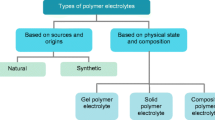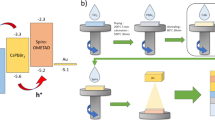Abstract
Porous titania films are widely studied in a number of optoelectronic applications due to its favorable optical and electronic characteristics. Mesoporous titania thin films (MTTFs) with tunable pore size, pore order, accessibility and crystallinity are of interest in electronic devices due to the potential for optimization of the desired characteristics for charge separation and carrier transport. In this work, several MTTFs were prepared by sol–gel chemistry with different structural properties tuned by post-synthesis thermal treatment. The effect of the structural properties (pore diameter, order and accessibility) on the electrical properties of the material was studied by films fabrication onto a transparent conducting electrode, ITO, such that it enables optoelectronic applications. The performance as photoanode was explored by the fabrication of hybrid polymer (P3HT): titania solar cells. Not only does structural properties affect polymer impregnation inside the titania pores as expected and hence impacts charge separation at the interface, but also the thermal treatment affects crystallinity and the films electronic properties. A more complete picture about the electronic properties of the different MTTFs prepared in this work was studied by mobility measurement by space charge limited current and impedance spectroscopy.






Similar content being viewed by others
References
Abrusci A et al (2011) Facile infiltration of semiconducting polymer into mesoporous electrodes for hybrid solar cells. Energy Environ Sci 4:3051–3058. https://doi.org/10.1039/c1ee01135a
Aduda BO, Ravirajan P, Choy KL, Nelson J (2004) Effect of morphology on electron drift mobility in porous TiO2. Int J Photoenergy 6:141–147. https://doi.org/10.1155/s1110662x04000170
Al-Hamdi AM, Rinner U, Sillanpää M (2017) Tin dioxide as a photocatalyst for water treatment: a review. Process Saf Environ Prot 107:190–205. https://doi.org/10.1016/j.psep.2017.01.022
Angelomé PC, Andrini L, Calvo ME, Requejo FG, Bilmes SA, Soler-Illia GJAA (2007) Mesoporous anatase TiO2 films: use of Ti K XANES for the quantification of the nanocrystalline character and substrate effects in the photocatalysis behavior. J Phys Chem C 111:10886–10893. https://doi.org/10.1021/jp069020z
Bai Y, Mora-Seró I, De Angelis F, Bisquert J, Wang P (2014) Titanium dioxide nanomaterials for photovoltaic applications. Chem Rev 114:10095–10130. https://doi.org/10.1021/cr400606n
Burkhard GF, Hoke ET, McGehee MD (2010) Accounting for interference, scattering, and electrode absorption to make accurate internal quantum efficiency measurements in organic and other thin solar cells. Adv Mater 22:3293–3297. https://doi.org/10.1002/adma.201000883
Cao L, Chen D, Li W, Caruso RA (2014) Hierarchically porous titania networks with tunable anatase: rutile ratios and their enhanced photocatalytic activities. ACS Appl Mater Interfaces 6:13129–13137. https://doi.org/10.1021/am502990r
Carreon MA, Choi SY, Mamak M, Chopra N, Ozin GA (2007) Pore architecture affects photocatalytic activity of periodic mesoporous nanocrystalline anatase thin films. J Mater Chem 17:82–89
Chen Y, Jiang H, Jiang S, Liu X, Zhang W, Zhang Q (2014) Influence of annealing temperature on the microstructure and electrical properties of indium tin oxide thin films. Acta Metall Sin 27:368–372. https://doi.org/10.1007/s40195-014-0059-x
Coakley KM, McGehee MD (2003) Photovoltaic cells made from conjugated polymers infiltrated into mesoporous titania. Appl Phys Lett 83:3380–3382
Crossland EJW, Noel N, Sivaram V, Leijtens T, Alexander-Webber JA, Snaith HJ (2013) Mesoporous TiO2 single crystals delivering enhanced mobility and optoelectronic device performance. Nature 495:215–219. https://doi.org/10.1038/nature11936
Dittrich T, Lebedev EA, Weidmann J (1998) Electron drift mobility in porous TiO2 (anatase). Phys, Status Solidi A, p 165
Fujishima A, Zhang X, Tryk DA (2008) TiO2 photocatalysis and related surface phenomena. Surf Sci Rep 63:515–582. https://doi.org/10.1016/j.surfrep.2008.10.001
Günes S, Sariciftci NS (2008) Hybrid solar cells. Inorg Chim Acta 361:581–588
Hartmann P, Lee D-K, Smarsly BM, Janek J (2010) Mesoporous TiO2: comparison of classical sol–gel and nanoparticle based photoelectrodes for the water splitting reaction. ACS Nano 4:3147–3154. https://doi.org/10.1021/nn1004765
Hoffmann MR, Martin ST, Choi W, Bahnemann DW (1995) Environmental applications of semiconductor photocatalysis. Chem Rev 95:69–96
Hwang T, Lee S, Kim J, Kim C, Shin B, Park B (2017) Tailoring the mesoscopic TiO2 layer: concomitant parameters for enabling high-performance perovskite solar cells. Nanoscale Res Lett. https://doi.org/10.1186/s11671-016-1809-7
Jafarzadeh M, Sipaut CS, Dayou J, Mansa RF (2016) Recent progresses in solar cells: insight into hollow micro/nano-structures. Renew Sustain Energy Rev 64:543–568. https://doi.org/10.1016/j.rser.2016.06.028
Mott NF, Gurney RW (1948) Electronic processes in ionic crystals. Clarendon Press, Oxford
Nambu A, Kondoh H, Nakai I, Amemiya K, Ohta T (2003) Film growth and X-ray induced chemical reactions of thiophene adsorbed on Au(111). Surf Sci 530:101–110. https://doi.org/10.1016/S0039-6028(03)00383-2
Rawolle M et al (2013) Infiltration of polymer hole-conductor into mesoporous titania structures for solid-state dye-sensitized solar cells. ACS Appl Mater Interfaces 5:719–729. https://doi.org/10.1021/am302255c
Schneider J, Matsuoka M, Takeuchi M, Zhang J, Horiuchi Y, Anpo M, Bahnemann DW (2014) Understanding TiO2 photocatalysis: mechanisms and materials. Chem Rev 114:9919–9986. https://doi.org/10.1021/cr5001892
Şennik E, Çolak Z, Kilinç N, Öztürk ZZ (2010) Synthesis of highly-ordered TiO2 nanotubes for a hydrogen sensor. Int J Hydrog Energy 35:4420–4427. https://doi.org/10.1016/j.ijhydene.2010.01.100
Shakeel Ahmad M, Pandey AK, Abd Rahim N (2017) Advancements in the development of TiO2 photoanodes and its fabrication methods for dye sensitized solar cell (DSSC) applications. A review. Renew Sustain Energy Rev 77:89–108. https://doi.org/10.1016/j.rser.2017.03.129
Stamate MD (2003) On the dielectric properties of dc magnetron TiO2 thin films. Appl Surf Sci 218:317–322. https://doi.org/10.1016/s0169-4332(03)00624-x
Violi IL, Perez MD, Fuertes MC, Soler-Illia GJAA (2012) Highly ordered, accessible and nanocrystalline mesoporous TiO2 thin films on transparent conductive substrates. ACS Appl Mater Interfaces 4:4320–4330. https://doi.org/10.1021/am300990p
Wright M, Uddin A (2012) Organic–inorganic hybrid solar cells: a comparative review. Sol Environ Mater Sol Cells 107:87–111. https://doi.org/10.1016/j.solmat.2012.07.006
Wu CH, Li H, Fong HH, Pozdin VA, Estroff LA, Malliaras GG (2011) Room-temperature preparation of crystalline TiO2 thin films and their applications in polymer/TiO2 hybrid optoelectronic devices. Org Electron 12:1073–1079. https://doi.org/10.1016/j.orgel.2011.03.004
Zakrzewska K (2004) Gas sensing mechanism of TiO2-based thin films. Vacuum 74:335–338. https://doi.org/10.1016/j.vacuum.2003.12.152
Zhang Y, Xie Z, Wang J (2009) Supramolecular-templated thick mesoporous titania films for dye-sensitized solar cells: effect of morphology on performance. ACS Appl Mater Interfaces 1:2789–2795
Zhang C, Luo Y, Chen X, Ou-Yang W, Chen Y, Sun Z, Huang S (2016) Influence of different TiO2 blocking films on the photovoltaic performance of perovskite solar cells. Appl Surf Sci 388:82–88. https://doi.org/10.1016/j.apsusc.2016.03.093
Zuo C, Bolink HJ, Han H, Huang J, Cahen D, Ding L (2016) Advances in perovskite solar cells. Adv Sci 3:1500324. https://doi.org/10.1002/advs.201500324
Acknowledgements
The authors are indebted to M. C. Marchi (CMA-UBA) for the SEM measurements and the Nanochemistry group at CNEA for the titania films preparation facility. J. Plá, G. J. A. A. Soler-Illia and M. Dolores Perez are permanent researchers at Consejo Nacional de Investigaciones Científicas y Técnicas (CONICET). A. Koffman-Frischknecht, F. Gonzalez and I. Violi are supported by CONICET fellowships. We thank IES-UPM for the calibrated reference sensor.
Funding
This work was supported by CNEA, ANPCyT (Grant PICT 1027-2013) and FUNINTEC-UNSAM (Grant INTERING 2016).
Author information
Authors and Affiliations
Corresponding author
Additional information
Publisher's Note
Springer Nature remains neutral with regard to jurisdictional claims in published maps and institutional affiliations.
Electronic supplementary material
Below is the link to the electronic supplementary material.
Rights and permissions
About this article
Cite this article
Koffman-Frischknecht, A., Gonzalez, F., Plá, J. et al. Impact of the titania nanostructure on charge transport and its application in hybrid solar cells. Appl Nanosci 8, 665–673 (2018). https://doi.org/10.1007/s13204-018-0639-6
Received:
Accepted:
Published:
Issue Date:
DOI: https://doi.org/10.1007/s13204-018-0639-6




